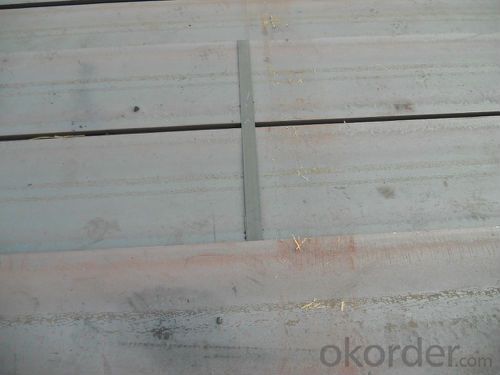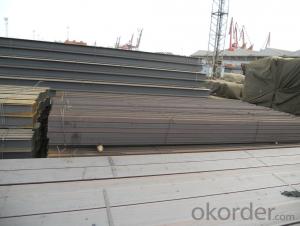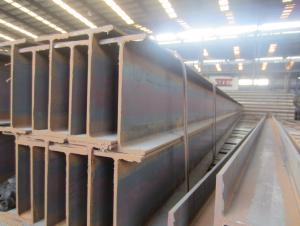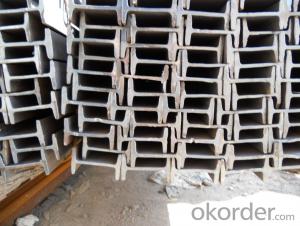JIS 3192 Hot Rolled Steel H-beam
- Loading Port:
- China Main Port
- Payment Terms:
- TT or LC
- Min Order Qty:
- -
- Supply Capability:
- -
OKorder Service Pledge
OKorder Financial Service
You Might Also Like
Product Description:
OKorder is offering JIS 3192 Hot Rolled Steel H-beam at great prices with worldwide shipping. Our supplier is a world-class manufacturer of steel, with our products utilized the world over. OKorder annually supplies products to European, North American and Asian markets. We provide quotations within 24 hours of receiving an inquiry and guarantee competitive prices.
Product Applications:
JIS 3192 Hot Rolled Steel H-beam are ideal for structural applications and are widely used in the construction of buildings and bridges, and the manufacturing, petrochemical, and transportation industries.
Product Advantages:
OKorder's JIS 3192 Hot Rolled Steel H-beam are durable, strong, and resist corrosion.
Main Product Features:
· Premium quality
· Prompt delivery & seaworthy packing (30 days after receiving deposit)
· Corrosion resistance
· Can be recycled and reused
· Mill test certification
· Professional Service
· Competitive pricing
Secifications of JIS 3192 Hot Rolled Steel H-beam
1. Standard: JIS 3192
2. Grade: SS400 or Equivalent
3. Length: 10m, 12m as following table
4. Invoicing on theoretical weight or actual weight as customer request
5.Payment: TT or L/C
6. Sizes:
H x B (mm) | T1 | T2 | JIS Weight (kg/m) | GB Weight (kg/m) |
100*100 | 6 | 8 | 16.9 | 17.2 |
125*125 | 6.5 | 9 | 23.6 | 23.8 |
150*75 | 5 | 7 | 14 | 14.3 |
148*100 | 6 | 9 | 20.7 | 21.4 |
150*150 | 7 | 10 | 31.1 | 31.9 |
175*90 | 5 | 8 | 18 | 18.2 |
175*175 | 7.5 | 11 | 40.4 | 40.4 |
198*99 | 4.5 | 7 | 17.8 | 18.5 |
200*100 | 5.5 | 8 | 20.9 | 21.7 |
194*150 | 6 | 9 | 29.9 | 31.2 |
200*200 | 8 | 12 | 49.9 | 50.5 |
248*124 | 5 | 8 | 25.1 | 25.8 |
250*125 | 6 | 9 | 29 | 29.7 |
244*175 | 7 | 11 | 43.6 | 44.1 |
250*250 | 9 | 14 | 71.8 | 72.4 |
298*149 | 5.5 | 8 | 32 | 32.6 |
298*201 | 9 | 14 | 65.4 |
|
300*150 | 6.5 | 9 | 36.7 | 37.3 |
294*200 | 8 | 12 | 55.8 | 57.3 |
300*300 | 10 | 15 | 93 | 94.5 |
346*174 | 6 | 9 | 41.2 | 41.8 |
350*175 | 7 | 11 | 49.4 | 50 |
340*250 | 9 | 14 | 78.1 | 79.7 |
350*350 | 12 | 19 | 135 | 137 |
400*200 | 8 | 13 | 65.4 | 66 |
390*300 | 10 | 16 | 105 | 107 |
400*400 | 13 | 21 | 172 | 172 |
446*199 | 8 | 12 | 65.1 | 66.7 |
450*200 | 9 | 14 | 77.9 | 79.5 |
440*300 | 11 | 18 | 121 | 124 |
496*199 | 9 | 14 | 77.9 | 79.5 |
500*200 | 10 | 16 | 88.2 | 89.6 |
488*300 | 11 | 18 | 125 | 129 |
596*199 | 10 | 15 | 92.5 | 95.1 |
600*200 | 11 | 17 | 103.4 | 106 |
588*300 | 12 | 20 | 147 | 151 |
700*300 | 13 | 24 | 182 | 185 |
800*300 | 14 | 26 | 207 | 210 |
900*300 | 16 | 28 | 240.1 | 243 |
Usage & Applications of Hot Rolled Steel H-beam
Commercial building structure ;Pre-engineered buildings; Machinery support structure; Prefabricated structure; Medium scale bridges; Ship-building structure.etc.
Packaging & Delivery of Hot Rolled Steel H-beam
1. Packing: it is nude packed in bundles by steel wire rod
2. Bundle weight: not more than 3.5MT for bulk vessel; less than 3 MT for container load
3. Marks:
Color marking: There will be color marking on both end of the bundle for the cargo delivered by bulk vessel. That makes it easily to distinguish at the destination port.
Tag mark: there will be tag mark tied up on the bundles. The information usually including supplier logo and name, product name, made in China, shipping marks and other information request by the customer.
If loading by container the marking is not needed, but we will prepare it as customer request.
4. Transportation: the goods are delivered by truck from mill to loading port, the maximum quantity can be loaded is around 40MTs by each truck. If the order quantity cannot reach the full truck loaded, the transportation cost per ton will be little higher than full load.
5. Delivered by container or bulk vessel
Production flow of Hot Rolled Steel H-beam
Material prepare (billet) —heat up—rough rolling—precision rolling—cooling—packing—storage and transportation
FAQ:
Q1: Why buy Materials & Equipment from OKorder.com?
A1: All products offered byOKorder.com are carefully selected from China's most reliable manufacturing enterprises. Through its ISO certifications, OKorder.com adheres to the highest standards and a commitment to supply chain safety and customer satisfaction.
Q2: How do we guarantee the quality of our products?
A2: We have established an advanced quality management system which conducts strict quality tests at every step, from raw materials to the final product. At the same time, we provide extensive follow-up service assurances as required.
Q3: How soon can we receive the product after purchase?
A3: Within three days of placing an order, we will begin production. The specific shipping date is dependent upon international and government factors, but is typically 7 to 10 workdays.


- Q:How do steel H-beams perform in high winds?
- Steel H-beams are renowned for their exceptional performance in high winds. Their structural design, featuring a broad flange and a vertical web, grants them superior strength and rigidity compared to materials like wood or concrete. Consequently, they exhibit high resistance to wind forces, ensuring stability during severe weather conditions. The H shape of the beams evenly distributes the load, minimizing wind-induced vibrations and reducing the risk of structural failure. Moreover, the vertical web provides added stiffness, enhancing their capacity to withstand lateral forces caused by high winds. Furthermore, steel H-beams can be custom-designed and manufactured to meet specific wind load requirements, making them suitable for various wind zones and regions with varying wind speeds. This flexibility allows for optimized performance in high winds, making them a reliable choice for structures in areas prone to strong gusts or hurricanes. In addition, steel is a highly durable and corrosion-resistant material, ensuring that steel H-beams remain resilient to the long-term effects of wind exposure. This characteristic guarantees their longevity and structural integrity, even under harsh wind conditions. To summarize, steel H-beams excel in high winds due to their superior strength, rigidity, and load distribution properties. Their ability to withstand wind-induced forces, combined with their durability, establishes them as a reliable choice for structures that must endure extreme weather conditions.
- Q:Can steel H-beams be used in seismic zones?
- Indeed, seismic zones can accommodate the use of steel H-beams. Steel is a highly favored material for seismic construction due to its remarkable strength, flexibility, and ductility. H-beams, or otherwise referred to as I-beams, offer exceptional structural support and possess the ability to endure the forces exerted during seismic events. To guarantee the secure utilization of steel H-beams in seismic zones, it is imperative to adhere to specific design and construction guidelines. These guidelines encompass various factors such as meticulously selecting the appropriate material grade, size, and shape of the beams, in addition to implementing proper connection and reinforcement detailing. Design considerations, such as the beam's moment of inertia, section modulus, and rigidity, significantly influence the beam's capacity to withstand seismic forces. Furthermore, the connections between the beams and other structural components should be designed to accommodate any potential lateral and vertical movements that may transpire during an earthquake. Compliance with local building codes and regulations that are specific to seismic zones is also of utmost importance. These codes typically outline precise design parameters, construction techniques, and material requirements that ensure structures can effectively withstand seismic activity. By diligently following these guidelines and adhering to local building codes, steel H-beams can be utilized proficiently in seismic zones, offering a secure and dependable structural solution.
- Q:How to control the welding deformation made of H steel
- Features are as follows: wide flange and large lateral rigidity. Good bending resistance. The two surfaces of the flange are parallel to each other, so that the connection, processing and installation are simple. Compared with the welding drawing I-beam, the utility model has the advantages of low cost, high precision, little residual stress, no expensive welding materials and welding seam detection, and the cost of steel structure production is saved by about 30%. Under the same section load, the H steel structure of hot rolled 15%-20% steel is less than that of traditional steel structure. Compared with the concrete structure, the hot rolled H steel structure can increase the use area of 6%, while the structural weight is reduced by 20% and 30%, and the internal force of the structural design is reduced. The H steel can be processed into T steel, and the castellated beams can form various section forms to meet the demands of engineering design and manufacture. H steel is mainly used in engineering, plant, equipment, machinery and equipment, bridges, highways, houses, etc., with good mechanical and physical properties, firm and energy-saving and environmental protection. H steel is a kind of economical type section steel, widely used in industry, buildings, bridges, oil drilling platforms, according to the forecast in 2005 China's H steel demand of about 2 million 500 thousand tons, 5 million tons of demand in 2010, but the H steel of China's annual production capacity of 1 million 200 thousand tons, the market demand is very great.
- Q:What are the different types of connections for steel H-beams in industrial buildings?
- There are several types of connections used for steel H-beams in industrial buildings, including bolted connections, welded connections, and moment connections. Bolted connections involve using bolts to join the beams together, providing a strong and easily adjustable connection. Welded connections involve melting and fusing the beams together using heat, creating a permanent and rigid connection. Moment connections are designed to resist rotational forces and allow for the transfer of moments between beams, resulting in a more flexible and efficient connection.
- Q:Can steel H-beams be used in the construction of railway bridges?
- Yes, steel H-beams can be used in the construction of railway bridges. They are commonly used due to their high strength, durability, and ability to withstand heavy loads, making them suitable for supporting the weight of trains and ensuring the structural integrity of the bridge.
- Q:How do steel H-beams perform in seismic retrofitting projects?
- Due to their exceptional ability to withstand seismic forces, steel H-beams are commonly employed in seismic retrofitting projects. These beams are specifically designed to distribute the energy generated during an earthquake, thereby minimizing the impact on the structure. Steel H-beams possess numerous characteristics that render them suitable for seismic retrofitting. Firstly, their high strength-to-weight ratio allows them to support heavy loads while remaining relatively lightweight. This quality is crucial in seismic retrofitting endeavors, as the additional weight of retrofitting elements must not exceed the capacity of the existing structure. Moreover, steel H-beams exhibit excellent ductility, enabling them to deform without fracturing. When an earthquake occurs, the ground shakes and the building undergoes movement, placing stress on the structure. Steel H-beams possess the capacity to flex and bend without breaking, effectively absorbing seismic energy and diminishing damage to the building. Furthermore, steel H-beams are easily installable and can be tailored to meet specific retrofitting requirements. They can be seamlessly connected to the existing structure, facilitating smooth integration. Additionally, their versatility permits various configurations and connections, making them adaptable to diverse retrofitting needs. In conclusion, steel H-beams present an ideal choice for seismic retrofitting projects due to their high strength-to-weight ratio, excellent ductility, and ease of installation. Their ability to distribute seismic forces and minimize structural damage makes them a reliable and efficient option for enhancing the seismic resilience of buildings.
- Q:How do you calculate the shear force in steel H-beams?
- To calculate the shear force in steel H-beams, you need to consider the applied loads and the internal forces acting on the beam. The shear force refers to the force that acts parallel to the cross-section of the beam, causing it to deform or fail. The first step is to determine the external loads acting on the beam, such as point loads, distributed loads, or moments. These loads can be determined from the structural design or from the specific application of the beam. Next, you need to determine the internal forces acting on the beam. In the case of shear force, the internal force is caused by the external loads and the structural configuration of the H-beam. The internal forces can be calculated using structural analysis methods, such as the method of sections or the moment-area method. Once you have determined the internal forces, you can calculate the shear force at any specific cross-section of the beam. This can be done by summing the forces acting on one side of the cross-section and setting it equal to zero. The shear force can be positive or negative, depending on the direction of the force. It is important to note that the shear force can vary along the length of the beam, especially if there are varying external loads or changes in the structural configuration. Therefore, it is necessary to calculate the shear force at different cross-sections along the length of the beam to fully understand its behavior. Overall, calculating the shear force in steel H-beams involves determining the external loads, analyzing the internal forces, and calculating the shear force at specific cross-sections. This information is crucial for ensuring the structural integrity and safety of the beam in various applications.
- Q:What are the common design considerations for steel H-beams in roofing applications?
- To ensure the structural integrity and safety of a roof, it is important to consider various design factors when using steel H-beams in roofing applications. 1. Load-bearing capacity: The steel H-beams must be designed to withstand the weight of the roof and any additional loads, such as snow, wind, or equipment. It is essential to properly size and space the beams to evenly distribute the loads and prevent any potential failure or collapse. 2. Span and support spacing: Careful consideration should be given to determining the span and support spacing of the steel H-beams based on the specific roof design and anticipated loads. Adequate support is necessary to prevent excessive deflection, sagging, or bending. The spacing between the beams should adhere to engineering standards and codes. 3. Connection details: The connections between the steel H-beams and other structural elements, such as columns or purlins, should be meticulously designed and executed. Strong and secure connections are crucial for proper load transfer and to avoid any disconnection or failure. 4. Fire resistance: Steel H-beams used in roofing applications should be designed to provide sufficient fire resistance. This can be achieved through the use of fire-resistant coatings, insulation materials, or the incorporation of fire-rated materials into the design. 5. Corrosion protection: Steel H-beams are susceptible to corrosion, particularly in outdoor roofing applications where they are exposed to the elements. It is necessary to implement appropriate corrosion protection measures, such as galvanizing or using corrosion-resistant coatings, to prolong the lifespan of the beams and maintain their structural integrity. 6. Thermal expansion and contraction: The design of steel H-beams should account for thermal expansion and contraction caused by temperature variations. This can be achieved by incorporating expansion joints or allowing for appropriate clearance and movement in the design. 7. Sustainability considerations: In modern design, sustainability plays a crucial role. Utilizing recycled steel or incorporating energy-efficient design elements can contribute to the overall sustainability of the roofing system. In conclusion, when designing steel H-beams for roofing applications, it is important to consider load-bearing capacity, span and support spacing, connection details, fire resistance, corrosion protection, thermal expansion and contraction, and sustainability. Addressing these design considerations will ensure that the steel H-beams provide a safe and durable roofing solution.
- Q:Are steel H-beams suitable for modular construction?
- Yes, steel H-beams are suitable for modular construction. H-beams, also known as I-beams or W-beams, are widely used in the construction industry due to their high strength-to-weight ratio and versatility. They are especially suitable for modular construction, a process that involves fabricating building components off-site and assembling them at the construction site. Steel H-beams offer several advantages for modular construction. Firstly, their structural strength allows for the creation of large, open spaces without the need for excessive support columns or walls. This makes them ideal for constructing modular buildings that require flexibility in interior layout and design. Additionally, H-beams are lightweight compared to their load-bearing capacity, making them easier to transport and handle during the modular construction process. Their prefabricated nature also reduces the time and labor required on-site, resulting in faster construction timelines and cost savings. Furthermore, steel H-beams have excellent durability and resistance to environmental factors such as fire, corrosion, and pests. This ensures that modular buildings constructed using H-beams have a longer lifespan and require minimal maintenance. Lastly, steel H-beams can be easily recycled, making them a sustainable choice for modular construction. Their high scrap value and recyclability contribute to reducing the environmental impact of construction projects. In conclusion, steel H-beams are highly suitable for modular construction due to their structural strength, lightweight nature, durability, and sustainability. They allow for the creation of flexible and spacious modular buildings while reducing construction time and costs.
- Q:What are the fire resistance properties of steel H-beams?
- Steel H-beams have excellent fire resistance properties due to their high melting point and low thermal conductivity. They can withstand extreme heat for a prolonged period without losing their structural integrity, making them a reliable choice for fire-resistant construction.
1. Manufacturer Overview |
|
|---|---|
| Location | |
| Year Established | |
| Annual Output Value | |
| Main Markets | |
| Company Certifications | |
2. Manufacturer Certificates |
|
|---|---|
| a) Certification Name | |
| Range | |
| Reference | |
| Validity Period | |
3. Manufacturer Capability |
|
|---|---|
| a)Trade Capacity | |
| Nearest Port | |
| Export Percentage | |
| No.of Employees in Trade Department | |
| Language Spoken: | |
| b)Factory Information | |
| Factory Size: | |
| No. of Production Lines | |
| Contract Manufacturing | |
| Product Price Range | |
Send your message to us
JIS 3192 Hot Rolled Steel H-beam
- Loading Port:
- China Main Port
- Payment Terms:
- TT or LC
- Min Order Qty:
- -
- Supply Capability:
- -
OKorder Service Pledge
OKorder Financial Service
Similar products
New products
Hot products
Related keywords































